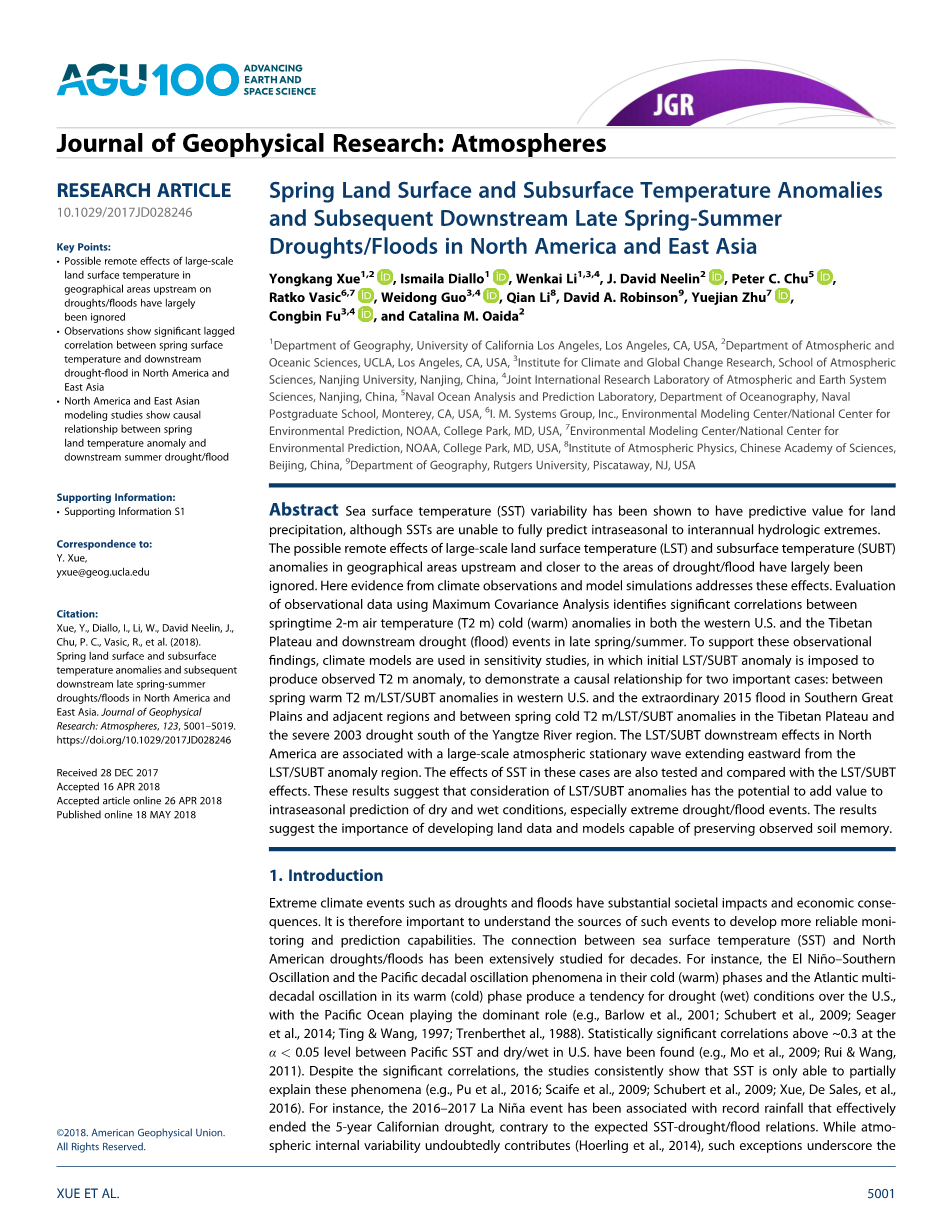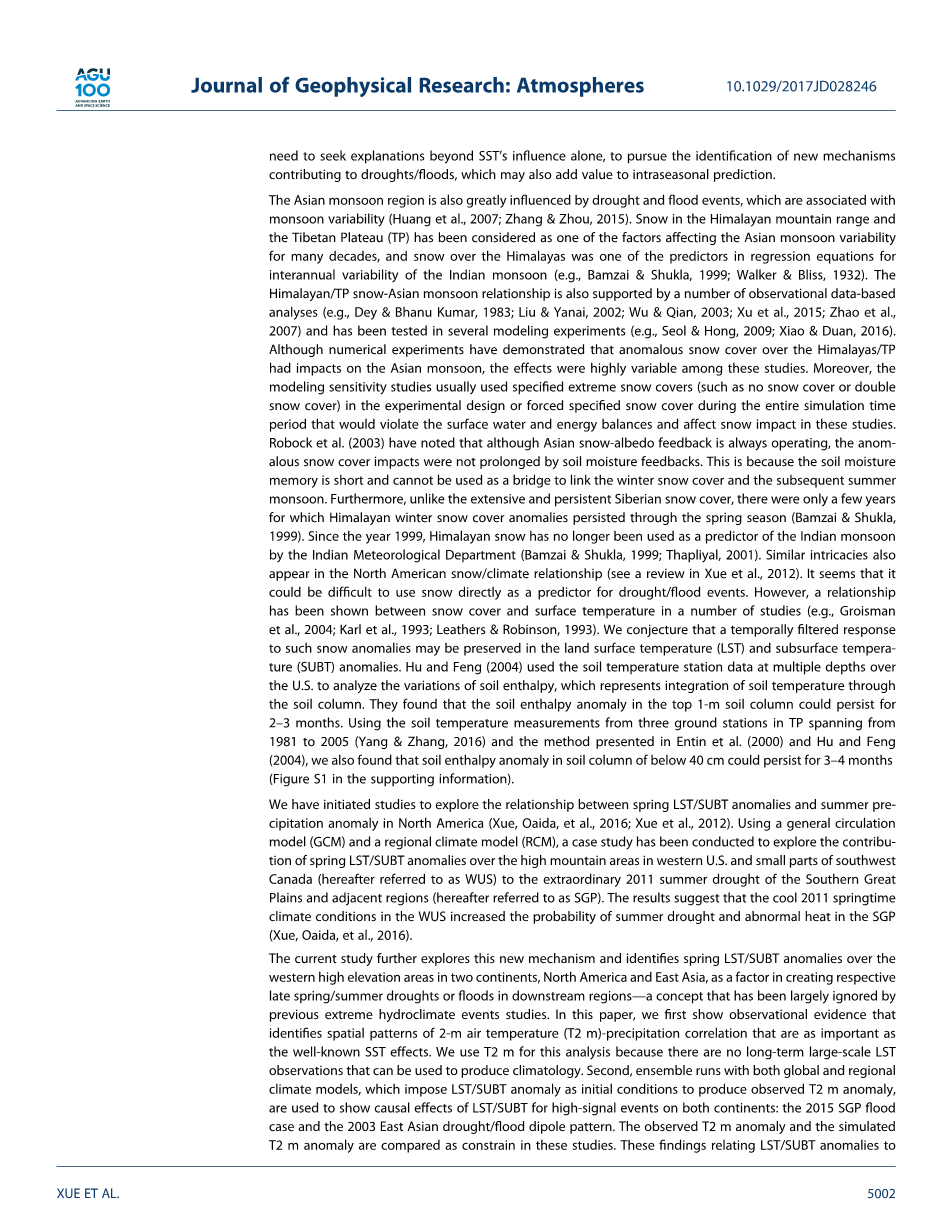

英语原文共 19 页,剩余内容已隐藏,支付完成后下载完整资料
北美和东亚春季地表和地下温度异常对随后的下游夏季降水情况的影响
Yongkang Xue1,2,Ismaila Diallo1,Wenkai Li1,3,4,J.David Neelin2,PeterC.Chu5,Ratko Vasic6,7,Weidong Guo3,4,Qian Li8,David A.Robinson9,Yuejian Zhu7,Congbin Fu3,4,and Catalina M.Oaida2
(1地理系,加利福尼亚大学洛杉矶分校,洛杉矶,加利福尼亚州,美国,2大气和海洋科学系,加利福尼亚大学洛杉矶分校,洛杉矶,加利福尼亚州,美国,3气候与全球变化研究所,大气科学学院南京大学,南京,中国,4国际大气和地球系统科学联合研究实验室,南京,中国,5海军海洋分析和预测研究室,海洋学系,海军研究生院,蒙特里,加利福尼亚州,美国,6信息管理系统组,环境建模中心/国家环境预测中心,美国国家海洋和大气管理局,大学园区,马里兰州,美国,7环境建模中心/国家环境预测中心,美国国家海洋和大气管理局,大学园区,马里兰州,美国,8中国科学院大气物理研究所,北京,中国,9地理系,罗格斯大学,皮斯卡塔韦,新泽西州,美国)
摘要:虽然海洋表面温度(SST)无法完全预测季节内至年际降水极端事件,但它的变化已被证明对陆地降水具有预测价值。人们总是忽视上游和较靠近旱涝地区的大范围地表温度(LST)和地下温度(SUBT)异常可能产生的远程影响。本文用气候观测及模型模拟验证了这些影响。利用最大协方差分析对观测数据进行评估,确定了在春/夏季后期,美国西部和青藏高原春季2米温度(T2m)的冷(暖)异常与美国西部干旱(洪涝)事件之间存在显著的相关性。为了验证这些观测结果,在敏感性实验中利用气候模型,将LST/SUBT异常与观测到的T2m异常相联系,以证明两个典型案例的因果关系:2015年美国西部春季T2m/LST/SUBT暖异常与美国南部大平原及其附近地区特大洪水事件的联系、2003年青藏高原春季T2m/LST/SUBT冷异常与长江以南地区严重干旱事件的联系。北美LST/SUBT下游效应与Rossby波从LST/SUB的异常区域向东延伸有关,并测试了SST在这种情况下的效果,并与LST/SUBT的影响进行了比较。这些结果表明,LST/SUBT异常可能对季节内旱涝事件的预测有影响,特别是对极端旱涝事件的预测有较大影响。研究结果表明,开发一种能够保存观测土壤数据的模式非常重要。
关键词:LST/SUBT效应;SST效应;T2m;旱涝
Spring Land Surface and Subsurface Temperature Anomalies and Subsequent Downstream Late Spring-Summer Droughts/Floods in North America and East Asia
Yongkang Xue1,2,Ismaila Diallo1,Wenkai Li1,3,4,J.David Neelin2,PeterC.Chu5,Ratko Vasic6,7,Weidong Guo3,4,Qian Li8,David A.Robinson9,Yuejian Zhu7,Congbin Fu3,4,and Catalina M.Oaida
1Department of Geography, University of California Los Angeles, Los Angeles, CA, USA, 2Department of Atmospheric and Oceanic Sciences, UCLA, Los Angeles, CA, USA, 3Institute for Climate and Global Change Research, School of Atmospheric Sciences, Nanjing University, Nanjing, China, 4Joint International Research Laboratory of Atmospheric and Earth System Sciences, Nanjing, China, 5Naval Ocean Analysis and Prediction Laboratory, Department of Oceanography, Naval Postgraduate School, Monterey, CA, USA, 6I. M. Systems Group, Inc., Environmental Modeling Center/National Center for Environmental Prediction, NOAA, College Park, MD, USA, 7Environmental Modeling Center/National Center for Environmental Prediction, NOAA, College Park, MD, USA, 8Institute of Atmospheric Physics, Chinese Academy of Sciences, Beijing, China, 9Department of Geography, Rutgers University, Piscataway, NJ, USA.
Abstract: Sea surface temperature (SST) variability has been shown to have predictive value for land precipitation, although SSTs are unable to fully predict intraseasonal to interannual hydrologic extremes. The possible remote effects of large-scale land surface temperature (LST) and subsurface temperature (SUBT) anomalies in geographical areas upstream and closer to the areas of drought/flood have largely been ignored. Here evidence from climate observations and model simulations addresses these effects. Evaluation of observational data using Maximum Covariance Analysis identifies significant correlations between springtime 2-m air temperature (T2 m) cold (warm) anomalies in both the western U.S. and the Tibetan Plateau and downstream drought (flood) events in late spring/summer. To support these observational findings, climate models are used in sensitivity studies, in which initial LST/SUBT anomaly is imposed to produce observed T2 m anomaly, to demonstrate a causal relationship for two important cases: between spring warm T2 m/LST/SUBT anomalies in western U.S. and the extraordinary 2015 flood in Southern Great Plains and adjacent regions and between spring cold T2 m/LST/SUBT anomalies in the Tibetan Plateau and the severe 2003 drought south of the Yangtze River region. The LST/SUBT downstream effects in North America are associated with a large-scale atmospheric stationary wave extending eastward from the LST/SUBT anomaly region. The effects of SST in these cases are also tested and compared with the LST/SUBT effects. These results suggest that consideration of LST/SUBT anomalies has the potential to add value to intra-seasonal prediction of dry and wet conditions, especially extreme drought/flood events. The results suggest the importance of developing land data and models capable of preserving observed soil memory.
Key Words: LST/SUBT effects; SST effects; T2m; droughts/floods
- 引言
干旱和洪水等极端气候事件对社会和经济有重要影响,因此分析此类事件的成因并开发更可靠的监测和预测模式非常重要。几十年来,海表面温度(SST)与北美旱涝之间的联系得到了广泛的研究。例如,ENSO和太平洋海温十年振荡现象在其寒冷 (温暖) 阶段、大西洋海温十年振荡在其温暖 (寒冷) 阶段在美国产生的干旱(洪涝)趋势, 以及太平洋海温在此过程中发挥的主导作用(Barlow等,2001年;Schubert等,2009年;Seager等,2014年;Tingamp;Wang,1997年;Trenberth等,1988年)。发现了太平洋SST和美国旱涝关系在alpha;lt;0.05的置信区间内存在统计上超过0.3的显著相关性(Mo等,2009年;Ruiamp;Wang,2011年)。虽然二者存在显著的相关性,但研究一致表明SST只能解释这些现象的部分内容(Pu等,2016年;Scaife等,2009年;Xue,De Sales等,2016年)。例如,2016-2017年的La Nintilde;a事件与破纪录的降水事件有关,这次事件结束了加利福尼亚州5年的干旱,但与通过SST预测的旱涝情况相反。虽然大气内部的变化是有原因的(Hoerling等,2014年),但这种例外突出表明需要寻求SST影响以外的解释,以确定影响旱涝的新机制,同时这对季节内预测具有重要意义。
干旱和洪水事件对亚洲季风区也有极大影响,这些事件与季风变化有关(Huang等,2007年;Zhangamp;Zhou,2015年)。几十年来,喜马拉雅山和青藏高原的积雪一直被认为是影响亚洲季风变化的因素之一,喜马拉雅山上的雪是印度季风变化年际回归方程的预测指标之一(Bamzaiamp;Shukla,1999年;Walkeramp;Bliss,1932年)。喜马拉雅/青藏高原积雪-亚洲季风关系也得到了一些基于观测数据的分析(Deyamp;Bhanu Kumar,1983年;Liuamp;Yanai,2002年;Wuamp;Qian,2003年;Xu等,2015年;Zhao等,2007年),并在几个模式实验中得到了测试(Seolamp;Hong,2009年;Xiaoamp;Duan,2016年)。虽然数值实验表明喜马拉雅山/青藏高原上空的异常积雪对亚洲季风有影响,但这些研究的影响差异很大。此外,在实验设计中通常使用指定的极端雪盖 (如无积雪盖或双雪盖) 的建模敏感性研究,或在整个模拟时间段内强制使用指定的积雪盖,从而违反地表水能量平衡,并影响这些研究中的雪的影响。Robock等(2003年)指出,虽然亚洲的雪反照率反馈总是在起作用,但土壤水分反馈并没有延长雪盖异常影响。这是因为土壤水分记忆很短,不能联系冬季雪盖和随后夏季季风。此外,与广泛和持续的西伯利亚积雪覆盖不同的是,喜马拉雅冬季到春季积雪异常仅持续了几年(Bamzaiamp;Shukla,1
剩余内容已隐藏,支付完成后下载完整资料
资料编号:[18906],资料为PDF文档或Word文档,PDF文档可免费转换为Word
您可能感兴趣的文章
- 气候变化对径流影响研究中多个gcm、统计降尺度和水文模型的比较与评价外文翻译资料
- 蒙古高原与青藏高原对北太平洋西风急流的影响外文翻译资料
- 用RAMS-CMAQ模拟北京气溶胶对大气能见度的影响外文翻译资料
- 春季江淮流域多尺度气旋活动及其与降水异常的关系外文翻译资料
- 中国东部地区春季1壤湿度和夏季降水关系的统计分析外文翻译资料
- 长江流域降水变率的AMIP GCM模拟外文翻译资料
- 中国水汽变化及气溶胶的影响外文翻译资料
- 大西洋盆地及其相邻大陆地区气溶胶的CALIPSO衍生三维结构外文翻译资料
- 基于雨量计观测数据的登陆中国的热带气旋的降水日变化外文翻译资料
- 基于CloudSat数据的热带云属现象描述外文翻译资料


